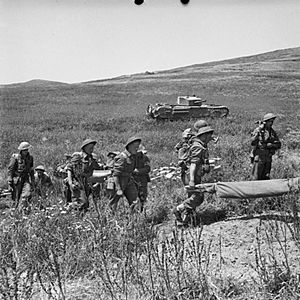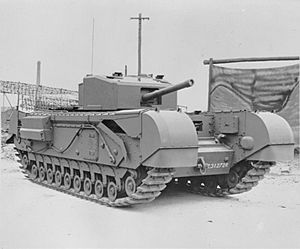Battle of Longstop Hill facts for kids
Quick facts for kids Battle of Longstop Hill (1943) |
|||||||
|---|---|---|---|---|---|---|---|
| Part of The Tunisia Campaign of the Second World War | |||||||
 British troops bring down wounded during the attack on Longstop Hill; a Churchill tank is in the background, |
|||||||
|
|||||||
| Belligerents | |||||||
| Commanders and leaders | |||||||
| Strength | |||||||
| Casualties and losses | |||||||
| roughly 400 killed and/or wounded | roughly 500 killed and/or wounded roughly 600 captured nonwounded |
||||||
The Battle of Longstop Hill was an important fight during World War II in Tunisia. It happened from April 21 to 23, 1943. British soldiers and their powerful Churchill tanks fought against German forces for control of a key area called Longstop Hill. This hill was actually two main peaks, Djebel el Ahmera and Djebel Rhar. The British, especially the 78th Battleaxe Division, won the battle. Their tanks did something amazing: they drove right up the steep hill, surprising the Germans. This victory was very important because Longstop Hill was the last big natural obstacle on the way to Tunis, the capital city.
Contents
Why Longstop Hill Was Important
After the Allies tried to capture Tunis in late 1942, the fighting slowed down. Both sides needed time to get stronger. The German and Italian armies in Tunisia were getting more soldiers and supplies. So were the Allied forces.
In early 1943, the German and Italian armies joined together. They were called Army Group Africa. But they were defeated in March 1943. In the central part of Tunisia, the British First Army kept fighting for control of important hills. These hills were held by the Germans. Longstop Hill was one of the most important of these hills. It was a group of peaks in the Medjerda Valley, about 30 miles (48 km) from Tunis.
The First Battle for Longstop Hill
There was an earlier fight for Longstop Hill in December 1942. British soldiers attacked the hill in heavy rain. They thought they had captured it all. But the Germans fought back and pushed them off one of the peaks. The British attacked again and took the hill back. However, the Germans launched another counter-attack on Christmas Day and took the hill back again.
Because of this, the Allied commanders decided to wait before trying to advance further. From then on, the Allies called the area "Longstop Hill." The Germans called it "Der Weihnachtsberg," which means "Christmas Mountain." By April 1943, the British had lost control of Longstop and other high ground nearby.
Planning the Attack
On April 20, 1943, British troops captured a nearby hill called Djebel Djaffa. They even managed to capture some German tanks there. The next day, the British 38th (Irish) Infantry Brigade captured another fortified town and rocky slopes. Taking these places meant that the high ground behind the town of Medjez was now safe. The next big target was Longstop Hill.
The commander of the 78th Division, Vyvyan Evelegh, ordered his soldiers to capture Longstop Hill. The attack would come from the southwest. Several British regiments were chosen for the attack. They were supported by Churchill tanks from the North Irish Horse and many artillery guns.
The plan was for two regiments, the Royal West Kents and the Buffs, to lead the attack. Another regiment, the Argylls, would then pass through them to capture Djebel Rhar, the higher part of Longstop. If successful, another regiment, the Surreys, with the tanks, would push further along the road towards Tebourba. The Germans defending the hill were from the 999th Light Afrika Division. They had prepared their defenses well with anti-tank guns, mortars, and machine gun nests.
The Battle Begins
On April 22, the British soldiers dug into positions, using any dips in the ground for cover. At 8:00 pm, 400 artillery guns began firing. This huge barrage lasted all night and signaled the start of the battle. The next morning, at 11:30 am, the Surreys and Argylls began to advance. But German machine guns and mortars immediately caused many casualties. The German soldiers fought back hard, stopping the West Kents and Buffs from taking Djebel Rhar. This delay meant the Argylls could not capture the main hills before it got dark.
Soon after dawn, the British commander realized his first plan was too difficult. He made a new plan for the Argylls and Surreys, supported by the North Irish Horse tanks, to capture Djebel Ahmera. This was the western half of Longstop Hill.
Capturing Djebel Ahmera
The Argylls were supported by two groups of North Irish Horse tanks. After heavy artillery fire, the Highlanders moved up the Djebel Ahmera ridge. They faced intense machine-gun fire. As they reached the base of the hill, their commanding officer was killed. The attack started to lose its shape. But Major John "Jock" Anderson quickly took command. He pushed the Argylls to keep going.
Even with many casualties, the Argylls climbed the hill. They soon reached the German defenders and began taking out the machine gun nests. Major Anderson showed great bravery, inspiring his men and destroying enemy strong points. For his actions, he was later given the Victoria Cross, a very high military award.
By nightfall, the Argylls, with help from the Surreys, had captured Djebel Ahmera. They also took 200 German prisoners. The West Kents moved closer to be ready. But an attempt to capture the next higher peak, Djebel Rhar, failed that night due to heavy mortar fire.
Clearing Sidi Ahmed Ridge
On April 24, the Surreys, another British battalion, and a group of tanks tried to clear the Sidi Ahmed ridge. This ridge was just north of Longstop Hill and had a white mosque used by the Germans as a defense point. The tanks helped the infantry get onto the ridge. They captured it despite heavy mortar and machine-gun fire. The British then strengthened their new positions, expecting a German counter-attack that never came.
Taking Djebel Rhar
On April 25, the British did not advance further. Instead, they made their positions on Djebel Ahmera stronger. The tanks stayed on the southern slopes. The capture of Djebel Rhar was planned for the next day.
On April 26, a diversionary attack began. The Germans responded with heavy mortar fire. This attack helped clear out hidden snipers and resulted in more prisoners. At the same time, the Buffs regiment moved forward with tanks on the lower northern slopes of the hill. Other tanks supported them on their main path.
The Churchill tanks did something amazing. They went down a steep gully between Djebel Ahmera and Djebel Rhar. Then, with the Buffs, they appeared on the northwest slopes. The tanks had climbed incredibly steep southern slopes. Tanks and infantry worked together, facing heavy mortar and small arms fire. The tanks reached the German defenses, surprising them. They destroyed the German strong points one by one with their machine guns and 6-pounder guns.
A tank led by Sergeant O'Hare was the first to reach the very top. It broke into the German headquarters and captured fifty prisoners. Three more tanks followed, having completed their extraordinary climb up slopes that were sometimes as steep as 1 in 3. The rest of the tank regiment arrived and moved up the slopes. With the Buffs, they eliminated more German strong points and cut off escape routes. By 11:00 am, the battle was over, and Longstop Hill was fully captured.
What Happened Next
The Buffs regiment lost nine soldiers killed and 83 wounded. But they and the North Irish Horse tanks captured over 300 prisoners, making the total 650. One German officer said that when he saw the tanks coming over the top of the hill, he knew the battle was lost. Other prisoners could not believe that tanks had climbed the hill until they were shown. One German soldier called the Churchill tanks "metal mules."
With Longstop Hill in British hands, they made their positions strong against any German counter-attacks. By April 27, the entire Longstop Hill area was secure. Longstop was the last major natural barrier on the way to Tunis.
On May 7, British tanks rolled into Tunis, surprising the German and Italian forces there. Many were caught coming out of shops and bars. By May 15, all German and Italian forces in Tunisia were surrounded. More than 250,000 soldiers surrendered. This defeat was so big that some people called it "Tunisgrad," comparing it to the huge German defeat at the Battle of Stalingrad.
See also
- List of British military equipment of World War II
- List of German military equipment of World War II



